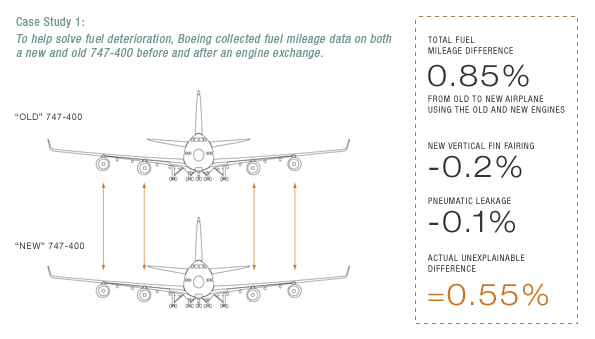
CASE STUDY 1:
Airframe versus engine — causes of fuel mileage deterioration
An airline that operates a 747-400 airplane fleet was concerned about what it considered to be excessive fuel mileage deterioration relative to the fuel mileage levels its airplanes exhibited when they were new. The airline requested help from both Boeing and the engine manufacturer in determining what was causing this deterioration — the airframe, the engine, or both. Through a better understanding of the contributions that airframe and engine deterioration make to the overall fuel mileage deterioration, the airline could more efficiently focus its maintenance resources.
To help resolve this issue, the airline proposed an experiment involving an engine exchange between an old and a new airplane. A six-year-old 747-400, which was operating about 4.1 percent below the flight planning database level of fuel mileage, represented the old airplane, while a soon-to-be-delivered 747-400 represented the new one. The airline requested assistance and support from Boeing and the engine manufacturer in carrying out the experiment, which would:
- Measure pre-exchange fuel mileage on both the new and the old airplane (pre-engine swap).
- Swap all four engines between the new and old airplane.
- Measure fuel mileage again on both the new and the old airplane (post-engine swap).
By using the same physical set of four engines on two different airframes, the airline, Boeing, and the engine manufacturer agreed that any measurable difference in fuel mileage for the same set of engines on two different airframes could be attributed to airframe effects alone — that is, drag deterioration.
Boeing’s position was that proper maintenance of the exterior of an airplane would lead to minimal amounts of drag deterioration as an airplane ages. As a result, the experiment began by putting the old airplane through a complete D-check, including a configuration inspection, so that it would be considered as having a properly maintained exterior before the engine swap. Control surfaces were rerigged, seals were repaired, and one engine was replaced. A minor leak in the pneumatic system, discovered during the D-check, was not fixed by the airline (determined to cause about a 0.1 percent penalty in fuel mileage). Fuel mileage data was collected before and after the D-check to determine any change across the check, especially to quantify any changes resulting from rerigging the flight control surfaces and replacing any worn seals. Fuel mileage improved 0.7 percent after the D-check, with 0.3 percent attributed to proper rerigging of the flight controls and 0.4 percent attributed to the changing of one engine.
Fuel mileage data was then collected on both the old and new airplanes before and after the engine swap. The data collected was a combination of in-service data collected by the airplane condition monitoring system (ACMS) and hand-recorded data that was collected under more controlled test conditions.
Average results from all four sets of data were then compared to determine the differences in fuel mileage between the old and new airplanes with the same set of engines.
For both the old and new engines, the average improvement in fuel mileage for the new airframe relative to the old airframe was about 0.85 percent. The initial conclusion could be that the older airframe must contribute about 0.85 percent toward the overall fuel mileage deterioration originally observed on the old airplane and engine combination. However, about 0.3 percent of that difference is explainable. Of the total calculated difference of 0.85 percent, the pneumatic duct leakage discovered on the old airplane during the D-check contributed about 0.1 percent. In addition, the old airplane did not have the same revised vertical fin fairing as the new 747-400. If the older airplane had had the newer vertical fin fairing, it is estimated that the fuel mileage would have improved about 0.2 percent.
After adjusting for the pneumatic system leak and the newer vertical fin fairing, for the same set of engines the old airplane’s fuel mileage averaged about 0.5 percent worse than the new airplane.
The results are supportive of the position that the drag deterioration of a well-maintained airplane most likely will not exceed more than about 0.5 percent.

